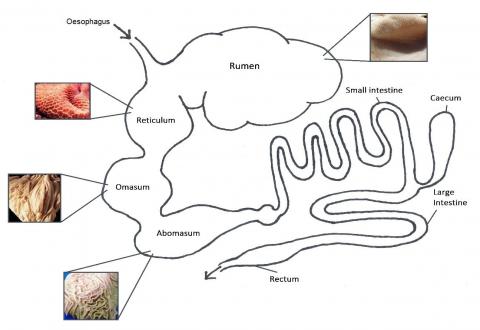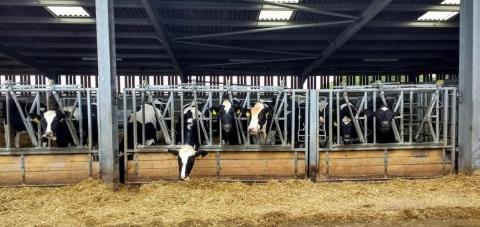1 August 2019
Dr Cate Williams: IBERS, Aberystwyth University.
- Nutrition is a key part of any ruminant production business, but the animal also needs to be equipped with a diverse and healthy rumen microbiome to allow them to make the best use of food.
- Weaning, transport, abrupt changes in diet and disease can all impact the rumen microbiome, leading to reduced digestibility, reduced feed conversion efficiency, instability in the rumen and poor overall performance.
- Feeding a balanced diet with good quality, long fibre forage will help maintain a healthy rumen and some may consider the use of supplements to help improve performance and rumen health.
The ruminant stomach is divided into four chambers, each with specialist functions (Figure 1). The rumen is the second chamber and houses a diverse population of microbes which enable the animal to breakdown plant material and convert it into high-quality nutrients (Figure 1). A healthy rumen is one of the most important factors in determining animal health as well as performance, as this is where the animal’s nutrients come from. A healthy rumen microbial population is dynamic and will adapt to shifts in the diet and the animal’s physiological status, but sudden changes in diet (e.g. weaning), disease, antibiotic use and stress can negatively affect rumen microbes causing problems for the animal.
Figure 1: Diagram of the ruminant digestive system and the linings of the four stomach chambers.
The importance of gut health
The microbial population of the ruminant gut enables the animal to breakdown tough plant-based substances which no animal alone is capable of. Substances such as cellulose, xylan and pectin are degraded by the rumen bacteria, fungi and protozoa to produce high-quality nutrients which can be utilised by the ruminant and converted into products like meat and milk. This is an excellent example of a symbiotic relationship – one where both parties benefit from the arrangement. A healthy and functional rumen microbiome is dynamic and will adapt to shifts in the environment, incoming food and the animal’s health and physiological status. The rumen microbiome will vary depending on several factors, the primary influence being diet with some genetic and geographical effects.
A healthy and efficient rumen microbiome is essential for animals to perform and to reach optimum productivity – be that in milk production, rearing lambs or growing to appropriate finishing weights. Feeding the animal a balanced and nutritious diet is only half the story, as the gut microbiota must be able to digest incoming food and make nutrients available to the animal. In beef and dairy production, some management and environmental factors can compromise gut health, for example, sudden changes in the diet, abrupt weaning, transportation, stress or disease. An abrupt change in diet, including weaning, can be detrimental to the animal and changes are best made gradually, allowing the microbiome to adapt and continue to provide the animal with sufficient nutrients. Observations of dairy cows exposed to heat stress have revealed a reduction in the diversity of the faecal microbiome and also altered immune function. A reduction in microbial diversity often leads to reduced and inefficient digestion as the full complement of necessary microbes simply is not present. The gut and the brain are connected on an ‘axis’ and interact intimately with one another to control the body’s functions and behaviour. In this way, a disturbance in the rumen microbiota can often be associated with the development of disease. For an effective immune response to be mounted, a considerable amount of essential nutrients are necessary, therefore, feeding an inadequate diet can directly compromise the animal’s immune system and reduce growth potential.
In dairy cows, sub-acute ruminal acidosis (SARA) or acidosis is a common problem. High-yielding cows require high-energy diets which inevitably consist primarily of concentrates which contain large quantities of carbohydrates. These feed-stuffs are ‘acid forming’, which in small quantities is dealt with by absorption into the rumen wall, but in large quantities (or when the diet is suddenly changed) the rumen cannot buffer its own pH, becoming acidic. Buffering of the rumen pH at around 6.2-6.5 is achieved through saliva production which contains sodium bicarbonate and has a much higher pH of 8, helping to even out rumen conditions. Maintaining optimum rumen pH allows the microbiota to operate at maximum efficiency, breaking down feed into usable nutrients for the animal. During SARA or acidosis, the rumen microbiome reduces in species diversity and richness, stability and fermentative capacity, depriving the animal of nutrients and leading to weight loss and diarrhoea.
Feeding for a healthy rumen
Often, producers are focussed solely on maximising production and performance in ruminant animals, however, it may be more beneficial, especially in terms of animal health, to concentrate on feeding for optimum growth and high quality meat and milk.
Four key factors influence the nutritional requirements of the ruminant: maintenance, growth, lactation and reproduction. A certain amount of nutrients are necessary for an animal to support digestion, tissue repair, daily activity and other housekeeping functions, however, a growing, lactating or pregnant animal will require significantly more or different nutrients than one in maintenance.
High-concentrate diets (50-90%) are highly digestible and ferment rapidly, resulting in quicker delivery of nutrients and faster growth rates. However, these unnaturally low-fibre diets can lead to significant health problems as the ruminant gut has evolved over many years to digest fibrous plant material. A high-concentrate diet allows acids to accumulate within the rumen, which can cause ulcers leading to abscesses on the liver and acidosis. Because the ruminant gut is not as well equipped to digest high levels of starch, grains can also accumulate in the ruminant’s intestines due to the lack of starch-digesting enzymes. This often promotes the growth of pathogenic bacteria in the gut, which can lead to serious health complications and death. Treating infections with antibiotics is effective, however, antibiotic therapy also impacts the ruminal microbial ecosystem, killing useful microorganisms and reducing nutrient availability.
As such, it is recommended that the ration of dairy and beef cattle consists of a minimum of 60% fibre (in the form of fresh roughage or silage). A wide variety of forage types are available, all with their own merits and drawbacks. Important qualities to consider when selecting a forage type are:
- Fibre length: Short chopped silage can reduce digestion and lead to SARA, the rumen is much better suited to digesting longer and coarser plant fibre.
- Feed costs: The main variable cost on any farm is often feed, so home-grown forages can help increase profitability and overall sustainability.
- Forage quality: In addition to containing good nutrients, forage should be free from fungi and moulds. Mouldy feed reduces palatability, digestibility and energy content and may also harbour dangerous mycotoxins.
- Grazing: Grazed pasture is the most cost-effective feed when it is grown and used efficiently. Ryegrass and clover mixes are particularly nutritious and can boost pasture yields.
- Supplementation: A high-fibre diet will inevitably need supplementation with some concentrates and feed additives, especially for high-yielding animals. Forage-based diets are low in protein, sugar and starch and may also need to be balanced with vitamins and minerals for optimum results.
Maximizing forage use should encourage optimum rumen function, however, it is important that feeding strategies do not compromise the health and welfare of livestock. For example, if the nutrient requirements of milking cows are not met (by restricting concentrate use for example) this will reduce the animal’s ability to combat diseases such as mastitis. Ketosis occurring as a result of negative energy balance, reduced fertility and other metabolic problems may also result from inadequate nutrient supply.
Feeding behaviour
In addition to nutritious and balanced feed, farmers may want to consider the feeding behaviour of ruminants. Particularly in housed cattle, limited space at the trough or the social hierarchy may drastically affect feed intake. Housed animals display significantly different feeding behaviour than those at grass, as the availability of feed changes over time, there is reduced availability of space and artificial lighting can interfere with feeding patterns.
Research has demonstrated that cows will sort a TMR (total mixed ration), and thus feed quality will decline throughout the day as cows pick out the best tasting or most nutritious bits. Therefore, cows that are forced to wait due to overcrowding or those that are lower down in the social hierarchy may consume a poorer quality diet, leading to inadequate nutrient intake and reduced milk yields. Furthermore, overcrowding can often lead to aggression as competition for food increases, this can heighten the risk of injury from kicks, hoof lesions from twisting and lameness in general.
Offering feed more frequently throughout the day can improve access and reduce sorting of the TMR. This could help minimise the variation in diet quality consumed by cows, with benefits for milk production and a reduction in the risk of SARA. Reducing overcrowding at the feed bunk also increases feeding time, reduces aggression and risk of injury.
Direct-fed microbials
Direct-fed microbials (DFMs) are living microorganisms which are used as a feed supplement to produce a beneficial impact on the host animal through improving the intestinal microbial balance. This encompasses a variety of organisms including yeasts, fungi, bacteria and fragments of microbial cells. DFMs may be used for a variety of reasons, but are most commonly applied prior to the start of rumination in calves to establish and maintain a stable and normal rumen microbiome. In general, bacterial feed supplements have been more effective in monogastric animals (pigs and poultry) and pre-ruminant calves, whereas fungal feed supplements have given better results in adult ruminants.
DFMs are now widely used in livestock production, yeast is frequently added to dairy cow diets as it is well accepted that the yeast culture can beneficially modify the rumen microbiota and boost the digestive and fermentative capacities of the rumen. Recent analysis has suggested that supplementation of yeast may improve performance and milk yield in dairy cattle through increasing feed intake and digestibility, stabilising rumen pH and decreasing the levels of lactic acid in the rumen. Like most microorganisms, yeast uses oxygen to grow, in contrast to the strictly anaerobic rumen microbes which need an oxygen-free environment – when applied to the rumen, yeast utilises any oxygen that might be present, stabilising the environment and promoting the growth of the rumen microbiota. Yeast itself may also persist in the rumen and contribute to the breakdown of cellulose and other plant compounds.
Supplementation with the fungus Aspergillus oryzae is well researched and proven to increase DM digestibility in high concentrate diets by stabilising the rumen environment and increasing numbers of cellulolytic bacteria. Several studies have also found that feeding A. oryzae to lactating cows results in higher milk fat or fat-corrected milk yields, milk protein and milk solids. This supplement is available commercially under several brand names and a dose of 3 g/day/cow is recommended (with higher doses showing no further improvements on rumen parameters or animal performance).
Summary
Ensuring that farmed animals are happy and healthy will result in improved farm performance, be that in milk yield, finishing weights, lamb quality or reduced running costs. Focussing on good nutrition for optimum growth and high-quality produce should be at the forefront of any business in livestock production. But, it is important to also ensure that animals are sufficiently equipped to make the most of the feed offered. This can be done by supporting the rumen microbiome (offering the correct type of feed, balancing the diet and feeding for a healthy microbial population) as it works to breakdown incoming food and supplies high-quality nutrients to the animal. The microbiome is related to immunity and disease in ruminants too, so providing the animal with good nutrition will also increase herd/flock health.


